- Over-valued tech stocks dented most by inflation fears
- Oil stabilizes following US pipeline cyberattack
- Bitcoin tumbles
Key Events
Yesterday's technology stock dump on Wall Street went viral on Tuesday, sweeping across the globe in pre-US open trading this morning. Inflation concerns are at the center of the sell-off. Futures on the Dow, S&P, NASDAQ and Russell 2000 have all slumped.
The dollar continues to struggle and Bitcoin continues falling.
Global Financial Affairs
Contracts on the NASDAQ and Russell—both sides of the reflation trade—slipped the most, while stocks less connected to the cyclical rotation are faring better, with S&P 500 futures down just 0.8% and futures on the Dow Jones Industrial Average, which includes reliable blue chip stocks, are outperforming, receding only 0.5%.
In Europe, the STOXX 600 index and the UK’s FTSE each plunged over 2%, after both indices scored fresh all-time high records in trading on Monday. The two benchmarks have also suffered their worst slump in three weeks. Indeed, their charts have developed similar patterns, but the pan-European gauge was further along.
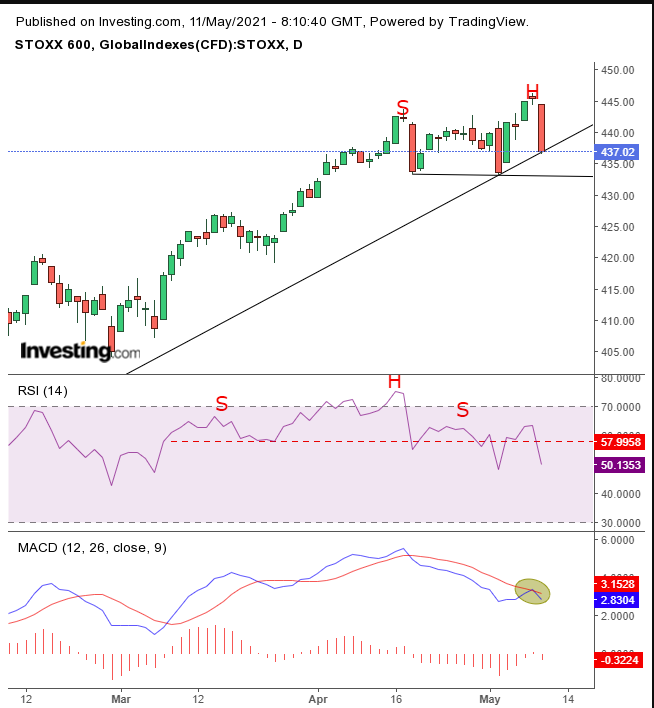
The STOXX 600 found support above its uptrend line, though it may be trading along a H&S top. The MACD confirmed its sell signal, and the RSI suggested that the price is set to complete a top.
Earlier in Asia, the MSCI Asia Pacific index fell the most since March. Japan’s Nikkei 225 shed 3% of its value, and stocks listed on Hong Kong’s Hang Seng dipped 2%.
China’s Shanghai Composite, though, rose 0.4%, after China reported a 6.8% jump, up from a 4.4% increase YoY, in the producer price index, its strongest increase on that metric since October 2017, as supply constraints cascaded into manufacturing. China’s economy was the first to recover from the coronavirus pandemic and the central bank there, the People’s Bank of China, has been adjusting policies to keep inflation in check.
US stocks slumped on Monday with technology stocks weighing on all indices. Surging commodity prices have heightened inflation anxiety and investors are now asking two US-focused questions that for now remain unanswered:
- Will inflation derail a growth rebound in the world’s largest economy and spoil a record stock rally?
- If inflation doesn't dent share price performance, will Fed tightening be needed to manage inflation, thereby causing a stock market slump?
The NASDAQ 100 fell 2.6%. Among the biggest losers: Apple (NASDAQ:AAPL) which also slid 2.6% and Tesla (NASDAQ:TSLA) which crashed, dropping 6.4%. The recent inflation scare is testing our bullish call on Tesla.

The real check for shares of the electric vehicle maker will be at $542.
The Dow topped 35,000 for the first time, but produced a powerfully bearish shooting star which found resistance by the previous, steeper uptrend line, suggesting a retest of the pennant and the main uptrend line.

The RSI provides a negative divergence.
Yields, including on the 10-year Treasury note, rose for the fourth straight day, but unlike the previous time the benchmark bond advance, this time stocks are falling.
The dollar continues to struggle.
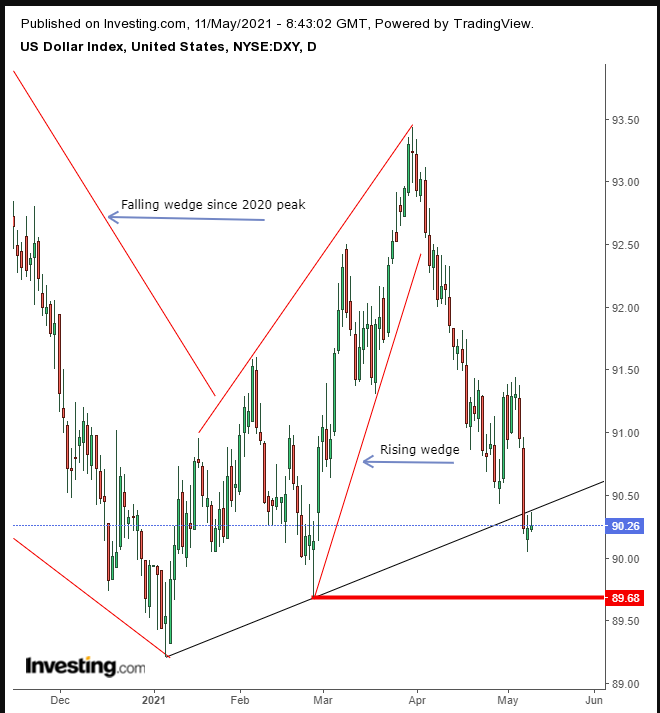
The greenback was unable to climb back above its uptrend line as two patterns—the recent, short-term wedge, and the larger, long-term wedge—have clashed.
Gold found resistance for the third day in a row.
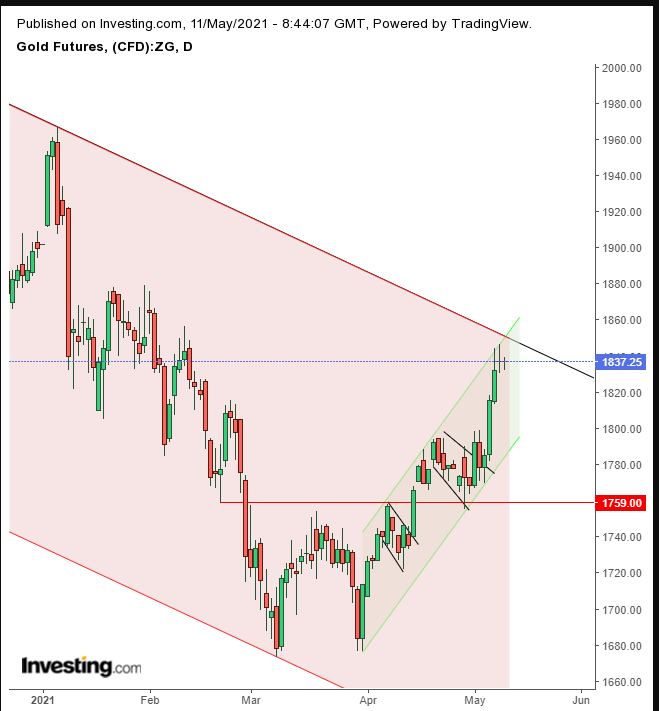
The yellow metal is at the top of its falling channel, despite dollar weakness, demonstrating a technical driver.
Bitcoin fell for the third day.
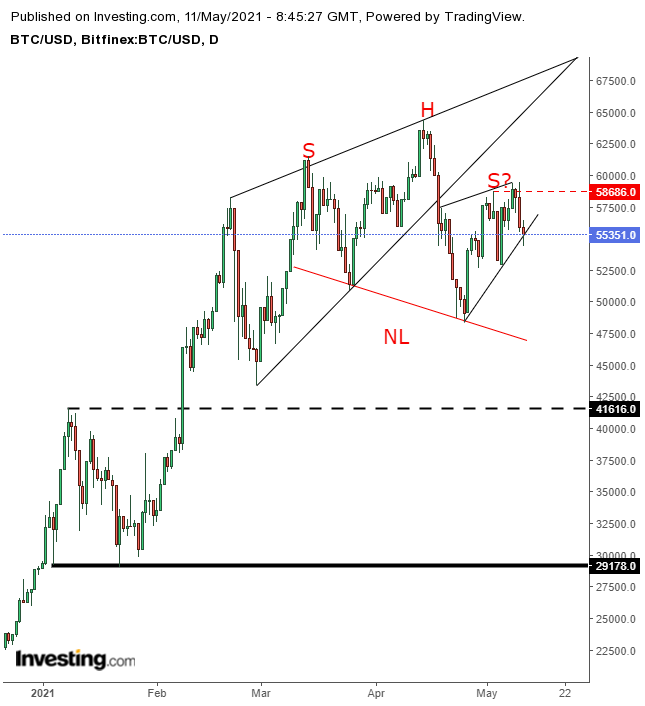
The most popular crypto by market cap is struggling against the bottom of a rising, bearish wedge, the second in a row, as it also paints the right shoulder of a H&S top, whose completion may halve its value.
Oil dipped as traders monitored progress on the reopening of the largest US oil-products pipeline, which was paralyzed by a cyberattack on Friday, and is expected to be mostly back online by the weekend.
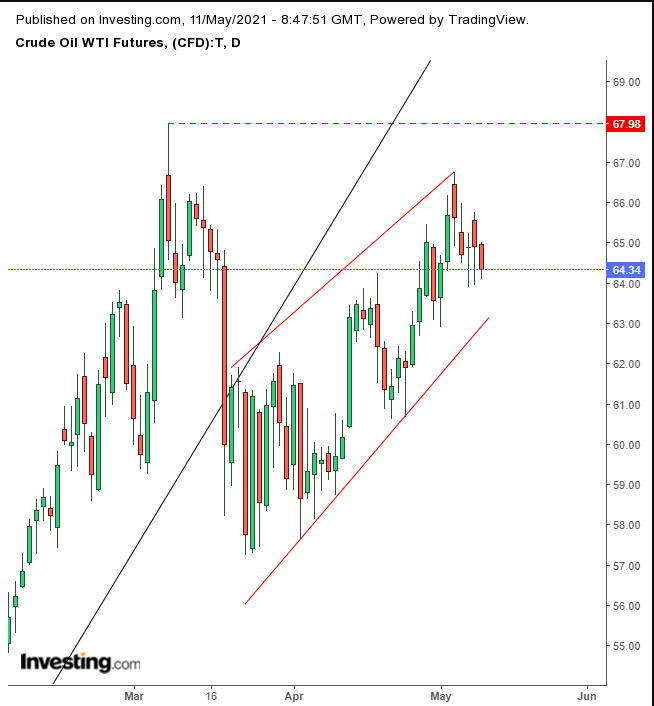
The price remains within a rising channel, which, however, is still below the uptrend line since the November bottom. If the price won’t top $68 soon, it will at least keep ranging, if not retest the $58 lows.
Up Ahead
- A range of Fed Reserve members are due to speak this week, including Governor Lael Brainard today.
- US CPI will be reported on Wednesday and is forecast to show prices continued to increase in April.
- On Thursday, initial jobless claims and PPI will be released.
Market Moves
Stocks
- Futures on the S&P 500 Index decreased 0.7%.
- The STOXX 600 Index sank 1.7%.
- The MSCI Asia Pacific Index sank 2%.
- The MSCI Emerging Markets Index sank 1.5%.
Currencies
- The Dollar Index declined less than 0.1%.
- The euro rose 0.1% to $1.2143.
- The British pound gained 0.1% to $1.4131.
- The onshore yuan weakened 0.1% to 6.426 per dollar.
- The Japanese yen weakened 0.1% to 108.89 per dollar.
Bonds
- The yield on 10-year Treasuries gained two basis points to 1.62%.
- The yield on two-year Treasuries climbed less than one basis point to 0.15%.
- Germany’s 10-year yield jumped four basis points to -0.17%.
- Japan’s 10-year yield decreased one basis point to 0.078%.
- Britain’s 10-year yield increased four basis points to 0.826%.
Commodities
- West Texas Intermediate crude declined 0.7% to $64.44 a barrel.
- Brent crude dipped 0.7% to $67.85 a barrel.
- Gold weakened 0.1% to $1,835.10 an ounce.
